It is an age of cut-throat in the digital world where the first impression counts. Onboarding can either lessen or increase the long-term participation of your users when they do not pay a subscription fee and engage in a discussion with your support team. Ineffective onboarding results in confusion, frustration and eventually, churn. Conversely, a well-flowing, hassle-free onboarding experience will turn new users into brand loyalty who appreciate the value of your product from the beginning.
SaaS onboarding tools have become crucial initiatives needed by companies to develop easy, interactive and customized user-experiences. These platforms also facilitate companies to take network users through functions, shorten time-to-value and increase activation rates. This guide is a complete tool on the best 10 SaaS onboarding tools to use in the year 2026 to make your business decision.
What is SaaS Onboarding?
Definition of SaaS Onboarding
Onboarding with SaaS is a strategic movement of accepting new users to your software and making them get to their initial successful deliverance. It is not simply a tutorial or a welcome screen but a highly developed tour that teaches users the features of your product, shows its value proposition and leads to the moments of activation. Smooth SaaS onboarding
Programs of interactive walkthroughs, tooltips, product tours, checklists, and educational materials can be combined to minimize friction and expedite user adoption. This is aimed at ensuring that users succumb to the signup to the so-called aha moment in the shortest possible time, where they gain a real grip on how your product will help them overcome their particular problem.
The contemporary approach to onboarding is data-driven, contextual, and is made to suit the various categories of users, their roles, and behaviors—often enhanced through the integration of AI Productivity Tools that automate and personalize the onboarding experience.
Benefits
- Lower Churn Rates: Right onboarding can lead to a decrease in user churn rates of up to 50 percent and ensure the customers not only stick around but also spend the initial critical 30 days engaged.
- Quicker Time-to-Value: The users will have a faster first milestone of success; they will experience the advantages of the product in hours, rather than in weeks.
- Higher Product Adoption: Interactive guidance makes users navigate more on what they could have neglected before thereby enhancing overall use.
- Reduced Support Costs: Customer support The burden on the customer support teams is also lowered by Self-service onboarding, which is active in responding to frequently asked questions.
- Greater Conversion Rates: According to industry data 2025 trial users who go through onboarding have superior chances at converting to paying customers 3 times higher.
- Improved User Data collection: Onboarding workflows provide useful feedback regarding their intentions and preferences to be personalized and overcome their issues.
- Enhanced Customer Satisfaction: Well trained and confident users will be referred to as product advocates provoking positive reviews and referrals.
- Scalable Growth: Automated onboarding will minimize the number of new employees the business has to hire throughout the years as thousands of new users can be supported.
Key Features to Look for in SaaS Onboarding Tools
- Interactive Product Tours: Capacity to design step programs with respect to illustrations of essential features without overpowering new users.
- Customization Flex: Choose and tailor the design to suit your company’s aspects in terms of visuals and voice.
- Segmentation Capabilities: Solutions to provide customized experiences, founded on the role, industry and behavior pattern of the user.
- Analytics Dashboard: Monitoring holistic measures related to completion rates of the journey, drop points off and user interest during the journey.
- Multi-Channel Support: Support of web, mobile applications, as well as emails in order to develop accurate cross-platform solutions.
- No-Code Implementation: Builders that are easy to use require no technical staff to develop and edit the flows used in the onboarding process.
- Progress Indicators: Checklists, progress bars and gamification items that encourage users to pass through onboarding processes.
- A/B Testing Capability: In-house testing capabilities to optimize the onboarding processes on actual performance data.
Top 10 SaaS Onboarding Tools (Free & Paid)
1. Appcues
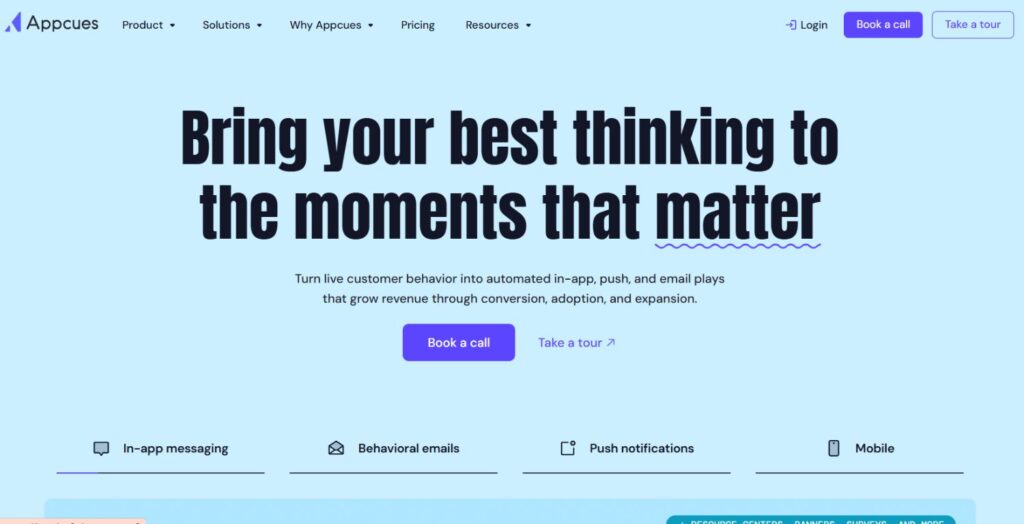
Best For / Use Case: Creating personalized in-app experiences for web and mobile applications without coding.
Appcues is one of the top onboarding platforms which enable product teams to create beautiful and focused user experiences. The tool is very effective in designing interactive product tours, tooltips, and modals to provide users with much-complicated workflows.
Customizing onboarding flows requires only a few minutes of visual building and they can be deployed right away without engineering input. Alongside modern AI Tools for Mobile App development, Appcues integrates seamlessly with SaaS solutions to enhance automation and personalization. Appcues has thousands of users in the world with a widespread popularity among mid-market SaaS businesses.
Key Features:
- Visual flow builder with drag-and-drop interface
- Advanced user segmentation and targeting rules
- NPS surveys and in-app feedback collection
- Mobile SDK for iOS and Android applications
- Real-time analytics with goal tracking
Pricing / Plans: Starts at $249/month for the Essentials plan, with custom pricing for Growth and Enterprise tiers.
Pros:
- Extremely user-friendly interface requiring no technical skills
- Robust analytics provide actionable insights
- Excellent customer support and extensive documentation
Cons:
- Can become expensive as monthly tracked users increase
- Limited customization options on lower-tier plans
- Occasional delays in mobile SDK updates
2. Userguiding
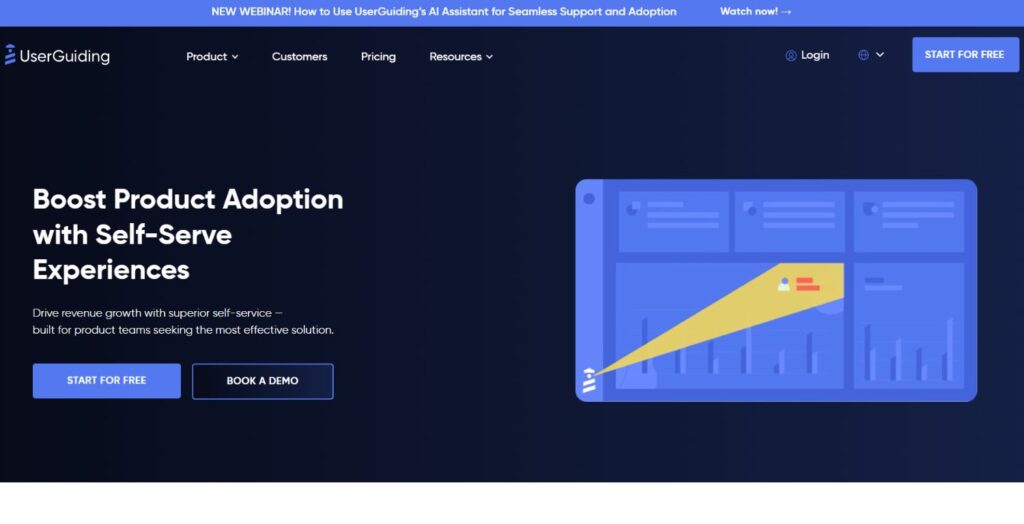
Best For / Use Case: Affordable onboarding solution for startups and small businesses seeking quick implementation.
Userguiding marketing itself as the low priced option to enterprise onboarding solutions without disclaiming the necessary capabilities. This tool enables teams to build interactive medical guides, product tours, and resource centers to enhance the activation of users. In 2025, the platform has seen great popularity in bootstrapped startups because of its open free plan and clear pricing. The simplicity of userguiding is all that a company that has not encountered structured onboarding requires.
Key Features:
- Interactive product tours and tooltips
- Customizable onboarding checklists
- In-app resource center with knowledge base
- Segmentation based on user attributes
- Hotspot notifications for feature announcements
Pricing / Plans: Free plan available; paid plans start at $89/month with unlimited guides and 2,500 monthly active users.
Pros:
- Most affordable option among comprehensive SaaS onboarding tools
- Quick setup process with Chrome extension
- Generous free tier for testing and small teams
Cons:
- Analytics capabilities less sophisticated than competitors
- Limited integrations compared to enterprise solutions
- Basic design customization options
3. Pendo
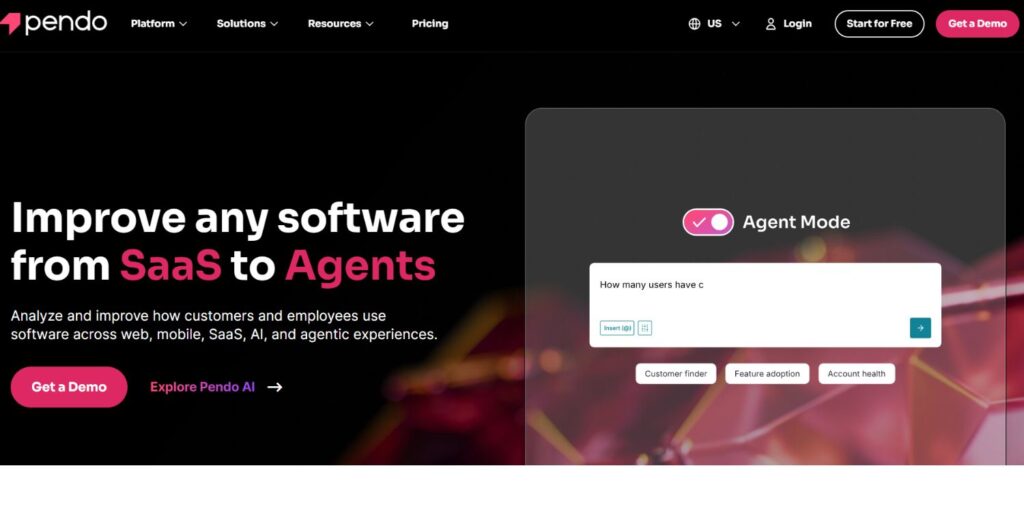
Best For / Use Case: Enterprise product analytics combined with comprehensive user onboarding and feedback capabilities.
Pendo is a unique all-in-one product experience platform, which can be defined as a combination of onboarding, analytics, and product feedback in one product. The platform is used with enterprise clients whose products are complex and whose user behavior needs a profound analysis as well as guided experiences.
The aforementioned leverages make Pendo applicable within the framework of relating onboarding success to retention rates over a period of time. In 2025, Pendo launched Pando Insights, which assists product team members to automatically discover opportunities to optimize products and improve integration with CRM Software solutions for enhanced customer engagement and retention.
Key Features:
- Comprehensive product analytics with retroactive data
- In-app guides and walkthroughs
- Product roadmap and feedback management
- Session replay capabilities
- AI-powered insights and recommendations
Pricing / Plans: Custom enterprise pricing based on monthly active users and feature requirements; typically starts at $2,000+/month.
Pros:
- Powerful analytics engine with deep behavioral insights
- Scalable solution supporting millions of users
- Strong integration ecosystem with CRM and data platforms
Cons:
- Significant investment required, prohibitive for small businesses
- Steep learning curve for new users
- Implementation can take several weeks
4. WalkMe
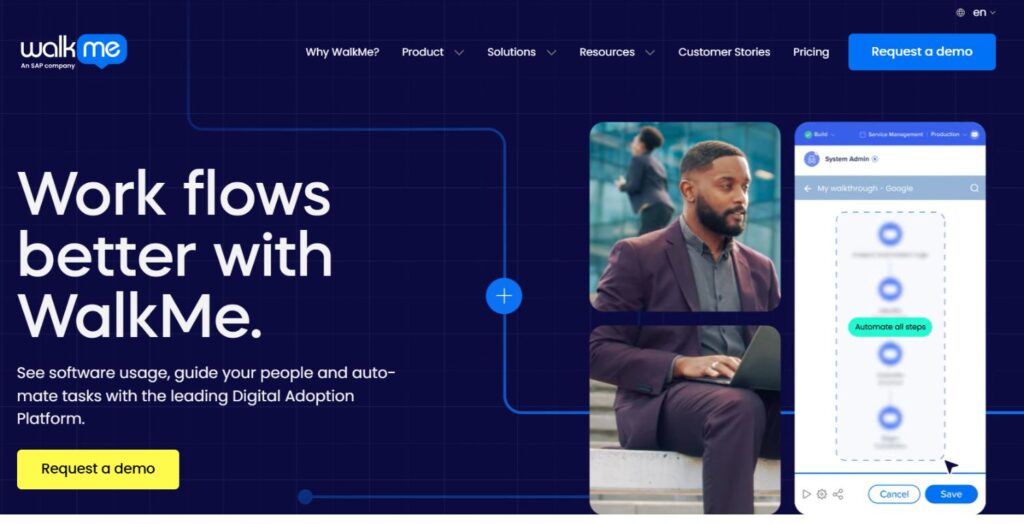
Best For / Use Case: Digital adoption platform for complex enterprise software and internal tool training.
WalkMe was the first provider of the digital adoption category and is the leader in terms of enterprise applications. In contrast to less complex SaaS onboarding tools, WalkMe supports more complex onboarding scenarios such as internal system employee training, customer onboarding of complex B2B solutions and guided workflows with multiple integrated applications. The platform relies on AI to give contextual support and automation to avoid friction when dealing with complicated workflows that can be transacted across multiple screens.
Key Features:
- Smart Walk-Thrus with conditional logic
- ActionBot for conversational assistance
- Insights dashboard with AI-driven recommendations
- Cross-application guidance
- Desktop and mobile app support
Pricing / Plans: Enterprise custom pricing; typically requires significant investment starting at $10,000+ annually.
Pros:
- Industry-leading capabilities for complex workflows
- Exceptional support for enterprise deployments
- Powerful automation reduces manual tasks
Cons:
- Premium pricing accessible only to large enterprises
- Requires dedicated resources for optimal implementation
- Overkill for simple SaaS products
5. Chameleon
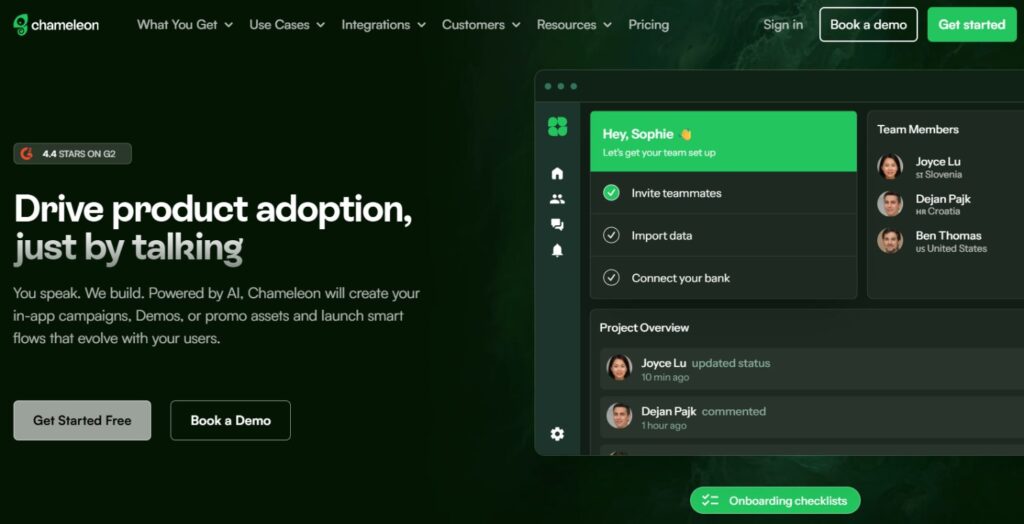
Best For / Use Case: Creating beautiful, highly customizable product tours for design-conscious SaaS companies.
Chameleon also focuses on flexibility and aesthetics meaning that product teams can build onboarding processes that are native to their application.
The platform has advanced targeting rules and falls in line with current tech stacks. Design-oriented companies that can not afford to sacrifice on the quality of the visual appeal befell into Chameleon in 2025. The tool will provide outstanding control of styling, animations, and positioning without the knowledge of CSS.
Key Features:
- Highly customizable UI components
- Microsurveys for gathering user feedback
- Launchers for persistent help access
- A/B testing for optimization
- HelpBar for in-app search and guidance
Pricing / Plans: Starts at $279/month for Startup plan; Growth and Enterprise plans with custom pricing available.
Pros:
- Superior design flexibility and customization options
- Clean, modern interface for building flows
- Strong focus on user experience quality
Cons:
- Slightly higher learning curve than simpler alternatives
- Pricing increases significantly with user volume
- Limited mobile app support compared to competitors
6. Intercom Product Tours
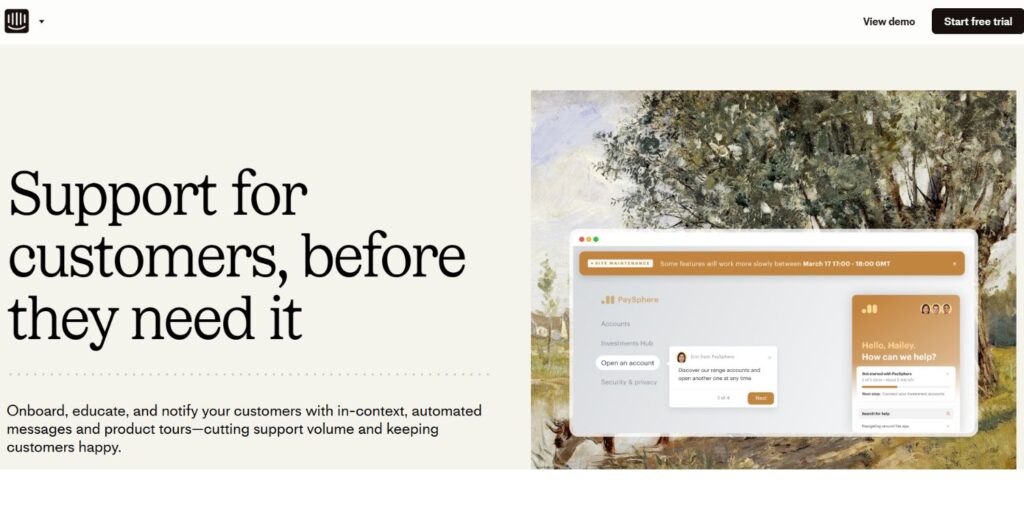
Best For / Use Case: Unified customer communication platform with integrated onboarding capabilities.
The Product Tours feature is a product extension that enables Intercom to launch a guided experience on top of its established support and engagement products by introducing onboarding space to the popular messaging product.
It is better than being divided – unifying the teams, it is possible to initiate onboarding tours with the help of support messages, and target messages with the help of tour completion and retain all customer context in one place. This integration became more useful in 2025 when corporations were trying to merge their tool stacks.
Key Features:
- Seamless integration with Intercom Messenger
- Behavior-triggered tours and messages
- Unified customer profiles across touchpoints
- Mobile app support via Intercom SDK
- Built-in analytics and reporting
Pricing / Plans: Available as add-on to Intercom subscription; starts at $79/month plus base Intercom cost.
Pros:
- Perfect for existing Intercom customers
- Unified platform reduces tool sprawl
- Excellent cross-channel coordination
Cons:
- Requires Intercom subscription as foundation
- Product Tours less feature-rich than specialized tools
- Can become expensive with multiple add-ons
7. Userpilot
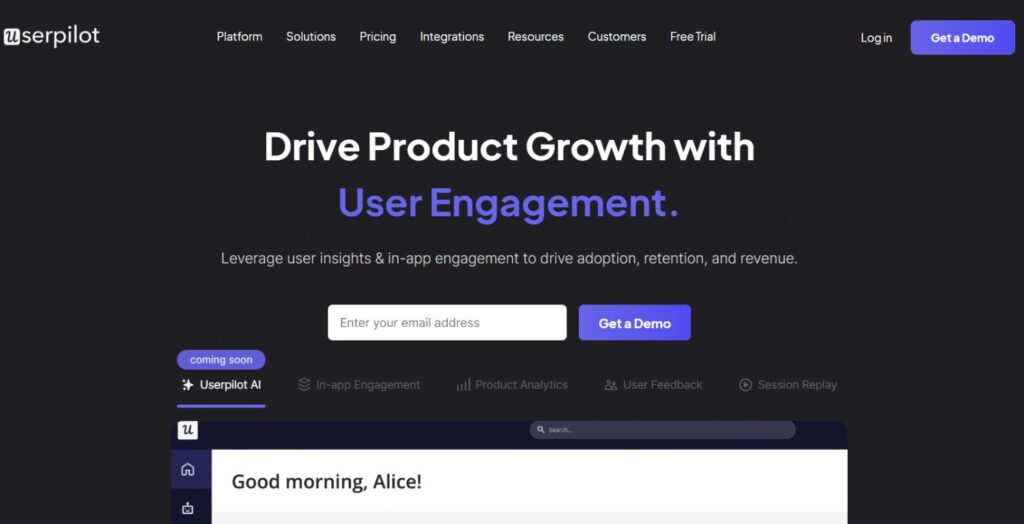
Best For / Use Case: Product-led growth companies focusing on user activation and feature adoption metrics.
Userpilot is directed at product-driven SaaS businesses when data-based onboarding optimization is an important objective. The platform has integrated onboarding classical features and sophisticated analytics whose particular goal is to gauge activation, feature-qualified qualifications, and product-qualified leads.
At some point in 2025, Userpilot came up with new AI-based recommendations, which propose the best onboarding routes based on the successful sets of users. It is the tool, which is highly valued in growth-oriented teams which constantly experiment and iterate.
Key Features:
- Product analytics and event tracking
- Custom user onboarding flows
- Feature tagging and adoption tracking
- NPS, CSAT, and CES surveys
- Automatic experience triggering
Pricing / Plans: Traction plan starts at $249/month for up to 2,000 MAUs; Growth and Enterprise plans available.
Pros:
- Strong balance between onboarding and analytics
- Excellent for measuring activation metrics
- Responsive customer success team
Cons:
- Interface can feel cluttered with many features
- Steeper pricing tiers compared to alternatives
- Limited template library for quick starts
8. Whatfix
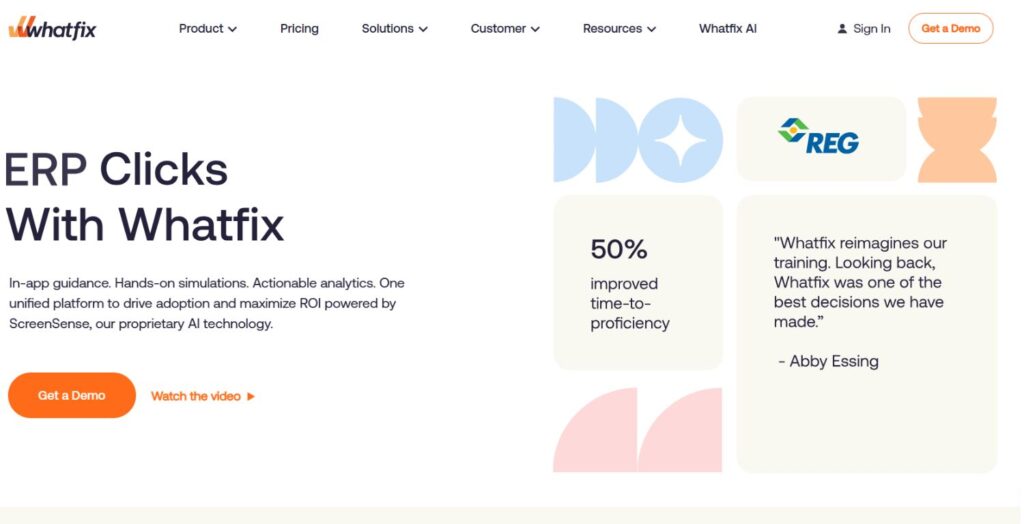
Best For / Use Case: Interactive guidance and performance support for enterprise applications and employee training.
Whatfix is used by companies that require training of their internal systems such as Salesforce, SAP or custom applications as well as enables customer onboarding. In 2025, the platform received fame due to its features of support in many languages and compliance in an accessible manner, which suits organizations around the world. Whatfix takes contextual help with analytics that identify areas where users need help to be instructed and improve training content and work flows constantly
Key Features:
- Smart tips and interactive walkthroughs
- Self-help widget with searchable content
- Task automation to simplify workflows
- Content analytics and engagement metrics
- Multi-language and localization support
Pricing / Plans: Custom enterprise pricing based on user count and deployment scope; contact for specific quotes.
Pros:
- Excellent for both customer and employee onboarding
- Strong compliance and accessibility features
- Comprehensive analytics for enterprise needs
Cons:
- Primarily enterprise-focused with corresponding complexity
- Implementation requires dedicated project resources
- Not ideal for small businesses or simple products
9. Stonly
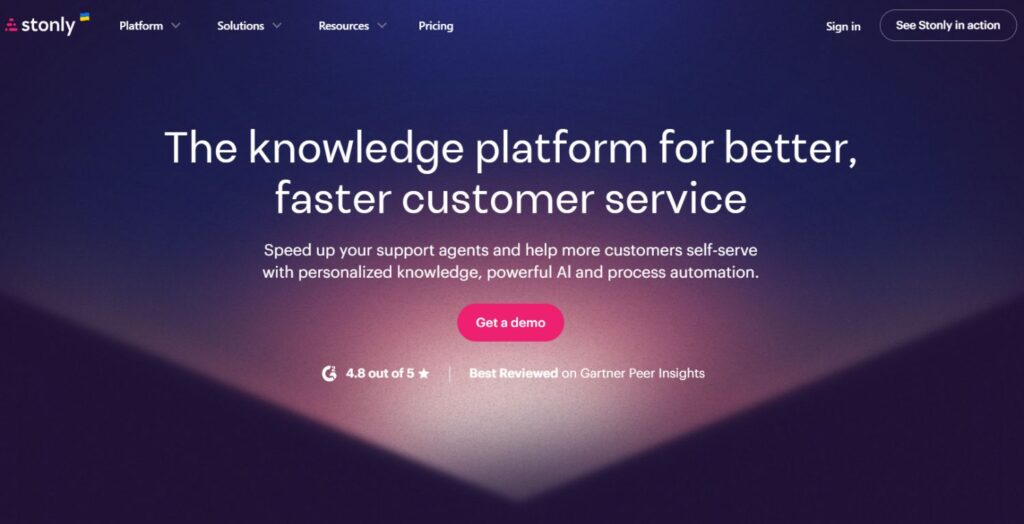
Best For / Use Case: Interactive knowledge base and decision tree guides for customer support and onboarding.
Stonly is the first SaaS onboarding tool to focus on branching logic and decision trees, as well as conventional product tours. This also makes it especially great with complicated products in which the types of users required to use it demand completely different onboarding channels.
The support teams can develop step-by- guy troubleshooting manuals on the platform, which also has the ability to be onboarding. In 2025, Stonly increased the functionality of its widgets, which comprised embedded interactive instructions in applications.
Key Features:
- Branching decision trees and interactive guides
- Embeddable widgets and knowledge base
- Answer bot for automated support
- Version control and content management
- Multilingual content support
Pricing / Plans: Starts at $249/month; custom pricing for larger teams and enterprise features.
Pros:
- Unique approach perfect for complex decision paths
- Reduces support tickets while improving onboarding
- Excellent content management capabilities
Cons:
- Less intuitive for traditional product tour creation
- Smaller ecosystem of integrations
- Analytics focused more on content than user behavior
10. Spekit
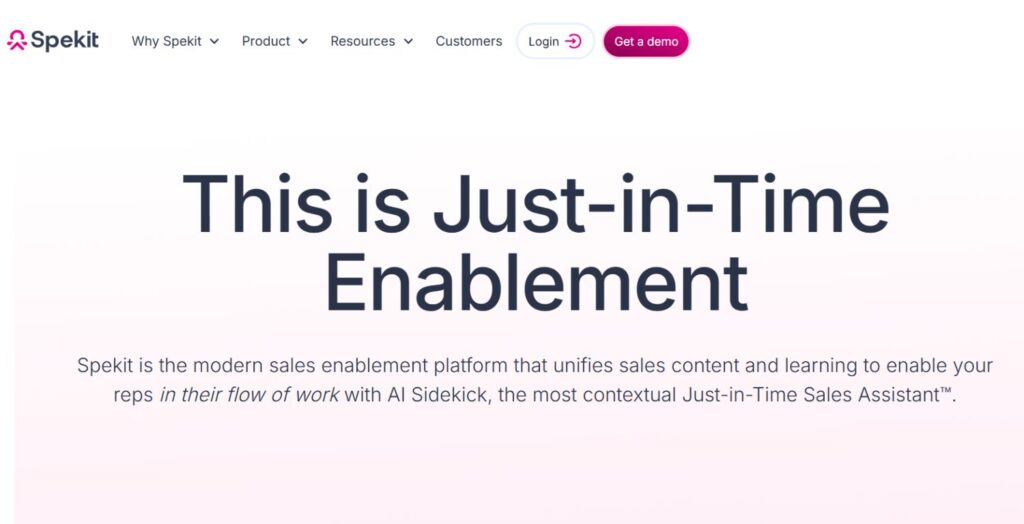
Best For / Use Case: Just-in-time learning and onboarding for sales teams using CRM platforms.
Spekit is a contextual enablement product that allows users to consume bite sized training material where and when it is required. Although it can be used across different applications, Spekit is especially beneficial in selling new members of the sales team onto a CRM application such as Salesforce or HubSpot.
The tool exposes the useful documentation, process tips and best practices in the workflow so that there is no need to switch applications. The strategy of training the distributed team through Spekit became quite popular in 2025 when remote work persisted.
Key Features:
- Contextual in-app wiki and documentation
- Spotlight notifications for announcements
- Quizzes and reinforcement learning
- Native integrations with major CRM platforms
- Role-based content delivery
Pricing / Plans: Custom pricing based on user count and platform integrations; typically starts at $8-$15 per user/month.
Pros:
- Laser-focused on reducing training time
- Seamless CRM integrations for sales enablement
- User-friendly content creation interface
Cons:
- Limited applicability outside specific use cases
- Not a comprehensive product analytics solution
- Smaller feature set compared to all-in-one platforms
How to Choose the Best SaaS Onboarding Tool
- Evaluate Product Complexity: Lightweight solutions are simple products, whereas robust platforms are required in enterprise applications that have complex logic and multiple steps.
- Take into consideration Your Technical Resources: Check whether you should use no-code solutions or you may utilize development resources to implement the solutions as more specific.
- Establish Your Budget Limits: Determine feature demands versus the costing systems- certain costs some tools are of a per-user fee and others are fixed.
- Assess Integration Needs: ABCE Checks: Make sure they can integrate with your current technology stack such as analytics and CRM as well as customer data platform.
- Review Analytics Capabilities: Decide how you want to use basic certain completion metrics or more intelligent behavioral analytics to make conversion funnels perform at their best.
- Test User Experience Quality: Make requests of demos and trials to see how the elements of onboarding really appear and feel in your application.
- Take into account Scalability Requirement: Select tools that will be able to scale with your business without necessitating a migration to higher levels as more users start to use it.
- Mobile Support: Does it have a mobile aspect to the product? Make sure onboarding tools are able to provide a feature-equivalent native mobile SDK.
Step-by-Step Guide to Implementing SaaS Onboarding
- Map Your User Journey: Chart your ideal user journey (i.e. Signup to First Value) and all the milestones of activation, and possible drop-off spots.
- Define Success Metrics: Setting clear KPIs such as activation rate, time-to-value percentage, feature adoption percentage, and completion rates is the way to go before developing anything.
- Segments Your Audience: Find various classes of users / use cases that should have customized onboarding experiences depending on either their goals or technical experience.
- Design Onboarding Flows: Allow progressively revealing functionality by designing guided tours, tool tips and checklists which are onboarded using wireframes or prototypes.
- Install Tracking Events: Configure effective analytics tracking to realize the progress of users within onboarding phases and determine strains.
- Build and Test Process: Have you used your selected SaaS onboarding tool; Build experiences and test extensively, across browsers, devices and user situations.
- Monitoring Initiating: Count onboarding a small group of users at launch and observing analytics as this will identify problems ahead of time before the complete rollout.
- Test and Improve: Repeat the analysis of the performance measures, user feedback, and A/B testing to maximize the conversion rates in the long run.
Conclusion
The choice of the right SaaS onboarding tools can radically change the experience of users of the product and ultimately the direction through which your business will grow. In each of the named platforms, it is possible to note the distinct advantages of each of them such as Appcues with its easy-to-use interface, Pendo with its all-inclusive analytics, or WalkMe with its complexity at enterprise level. It is important to align the abilities of the tools and your business requirements, technical capabilities, and financial limitations.
Making our way through 2026, the prosperous companies have understood that onboarding is not a project but a continuous process of optimization. With an effective onboarding, measurement, and continuous experience optimization, you will lower the rate of churn, will speed up the activation, and will create a base of loyal customers. It should be remembered that the most potent SaaS onboarding tools can never be that effective as the strategy underlining them.
FAQs
What are onboarding tools for SaaS?
SaaS onboarding tools platforms SaaS onboarding tools are systems that assist companies in interactive guiding, product tours, and tooltips to train new users on their products and activate them more quickly without using any program coding skills.
What are the SaaS onboarding services prices?
Basic plans, such as Userguiding cost as low as 89/month, whereas mid-tier, including Appcues, Userpilot, are costing between 249-500/month, and enterprise plans, including Pendo, WalkMe, have costs ranging between 2,000-10,000 and beyond. Many offer free trials.
Are SaaS onboarding tools coded using non coding?
In fact, the majority of contemporary SaaS onboarding tools have visual, no-code, drag-and-drop onboarding flow editors, which enable product managers and marketers to build onboarding processes without any technical background.
What is the best SaaS onboarding tool in the case of a startup?
Userguiding and Chameleon are suitable for startups because of affordable price, fast installation and essential features. They are simple to use and do not incur enterprise-level costs and complications.



